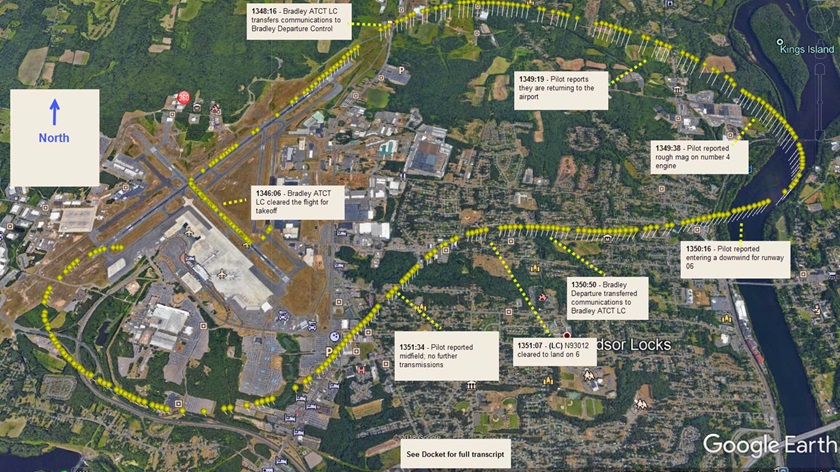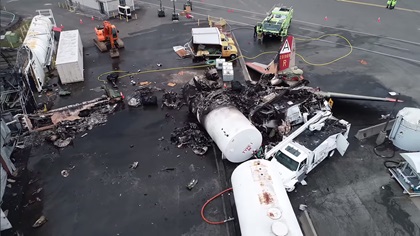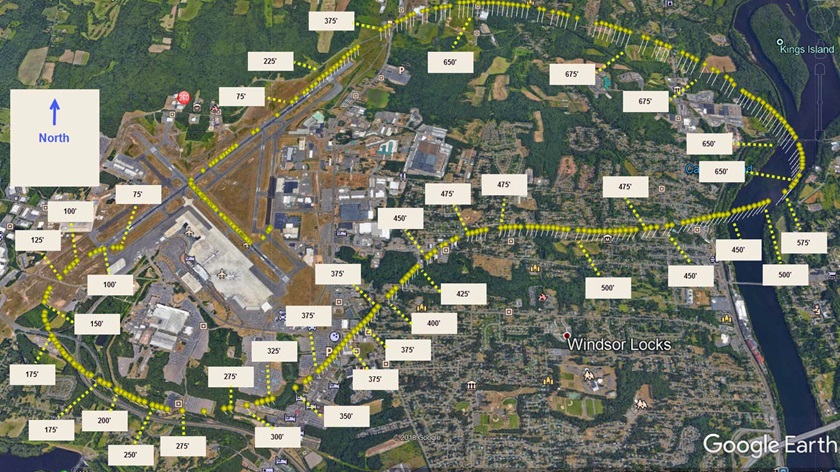NTSB opens docket on Collings Foundation B–17 crash
Probable cause determination to come
The NTSB opened to the public hundreds of pages of documents generated by the investigation into the October 2019 crash of a Collings Foundation Boeing B–17 Flying Fortress that killed seven people. While the agency has yet to determine a probable cause, factual reports in the docket create a detailed picture of what happened.

The public docket for the investigation posted online December 9 contains hundreds of pages, including witness interview reports, findings from detailed examination of two of the bomber’s four engines, and other material that enables a chilling re-creation of the ill-fated flight of the vintage bomber dubbed Nine O Nine. An agency spokesman told local media that the information was released in the interest of transparency and asked the public to continue to be patient while the agency works to make a probable cause determination.
Investigators focused on the two engines on the right wing of the aircraft, engines No. 3 and 4. Engine No. 4 had been shut down and the propeller “feathered” in flight, a fact corroborated by the surviving crewmember who was aboard, and physical evidence.
“The disassembly and examination of the two engines did not reveal any preexisting mechanical defects or failures. However, the examination of the No. 3 engine’s pistons and spark plugs showed evidence of detonation that would have resulted in a significant loss of engine power,” the powerplant group’s factual report states.
The flight departed Runway 6 at Bradley International Airport in Windsor Locks, Connecticut, and reported intent to return to the airport soon after being handed over to departure control, still on a right crosswind. ADS-B data compiled by investigators indicate the aircraft was about 600 feet above field elevation at the time the crew requested a return to the airport, though they declined an air traffic controller’s offer of assistance.
“The controller then asked for the reason for the return to the airport, and the pilot replied that the airplane had a ‘rough mag’ on the No. 4 engine,” the Aircraft Performance ADS-B Study states. “The controller then instructed the pilot to fly a right downwind leg for runway 6 and confirmed that the flight needed an immediate landing. He subsequently cancelled the approach of another airplane and advised the pilot to proceed however necessary to runway 6. The approach controller instructed the pilot to contact the tower controller, which he did.”
Descending to about 300 feet agl at the midfield point of the right downwind, McCauley and Foster were faced with a dilemma that the ADS-B Study details: the asymmetric thrust created by left-wing engines operating normally while the two on the right wing were producing reduced power at best. According to the ADS-B data plot, the aircraft was a little more than 2,000 feet from the approach end of Runway 33, directly off the stricken aircraft’s right wing at this point in the flight.
“Compensating for the loss of right-wing thrust by increasing the thrust on the left-wing engines (#1 and #2) would have exacerbated the thrust asymmetry, and required additional rudder to prevent the airplane from yawing to the right,” the report states. “Consequently, the amount of additional thrust that could have been provided by the left-wing engines might have been limited not only by the maximum power output of those engines, but also by the amount of rudder available to compensate for the thrust asymmetry; once the maximum rudder is applied, any further increase in the thrust asymmetry will result in a right yaw.”

Investigators calculated that it was theoretically possible for the stricken bomber to have returned to the runway from which it had launched, despite the loss of power in two engines.
“The effect of airspeed on power required, flight path angle, and rate of climb is also presented, and indicates that during most of the flight, the airspeed was below the airspeed that would maximize the flight path angle (the condition required for maximizing the distance flown for a given altitude loss), and suggests that the airplane might have been able to clear the runway approach lights and reach the runway 6 threshold if the airspeed during the return to the airport had been higher (and/or if the landing gear had been kept raised until landing was assured).”
The FAA, when revoking the Collings Foundation’s living history flight exemption in March, noted maintenance issues and defects found by investigators in both of the right-side engines.
“Regarding engine 4, to prevent the magneto 'P' leads from separating from the magnetos, someone had attempted to rig the magneto leads in place with safety wire. Inspection and testing of engine 4 left magneto revealed the movement of the safety-wired lead caused grounding to the case, which rendered the magneto lead inoperative. In addition, the right magneto of engine 4 was found unserviceable,” the agency stated in its decision. “An inspection of engine 3 showed all spark plugs electrode gaps were out of tolerance, fouled, and revealed various signs of detonation. Further inspection of this engine revealed problems with the cylinders.”
The FAA noted also that McCauley served as both pilot in command and the organization’s director of maintenance, and that, “As a result of these findings and other information, the FAA questions whether the engines were inspected adequately and in accordance with the applicable maintenance requirements.”
The Operational Factors Group Chairman’s Factual Report in the NTSB docket states that the foundation operated with minimal FAA oversight following the death of the foundation’s point of contact at the flight standards district office in Orlando, Florida, in 2017.
“The Collings foundation chief pilot stated in a conversation, that after the POC passed away, the FSDO advised them to use a general email mailbox for their correspondence with the FSDO. The Chief pilot further stated, they would send notifications that were required by their exemption letter to the general mailbox but after several of the emails and notifications were not answered, the Collings Foundation stopped using the general mailbox,” the report states. “As a result, the Collings Foundation operated with minimal to no FAA oversight.”
The Collings Foundation told local media that it is prohibited from commenting on the investigation, to which it is a party, while the investigation is pending.




